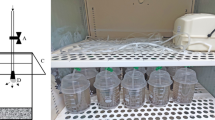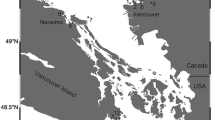Abstract
The U.S. Environmental Protection Agency is in the process of developing Sediment Quality Criteria (SQC) to specify the acceptable degree of risk from sediment-mediated chemical exposure for the protection of benthically-coupled organisms. In this study, potential differences in chemical exposure for benthic organisms of differing habitats or feeding types were evaluated through the use of Biota-Sediment Accumulation Factors (BSAFs). It was hypothesized that If species of different habitats have similar exposures, then the BSAF values should not be different. The BSAFs are calculated using the concentrations of chemicals in an organism (μg/g lipid) divided by the concentrations of the same chemicals in sediment (μg/goc). Data from both freshwater and saltwater studies that met specified criteria for data quality were obtained from published papers or reports. These included three laboratory and five field studies containing 27 species and 4054 BSAF values. The BSAFs were intercompared for similarity of central tendency as grouped by chemical class (PCBs, PAHs, pesticides), individual species, and species grouped by habitat (infaunal deposit feeder, scavenger, filter feeder, and benthically-coupled fish). Plots of BSAFs grouped by class and Kow revealed that the BSAFs for the PAHs were uniformly lower (mean 0.34) than the PCB (1.03) or pesticide (1.36) classes. For the PCBs, the BSAFs for all species exhibited a Kow dependency with decreased bioaccumulation evident above and below the range of 5.99–7.27 log10 Kow. In order to optimize the detection of species/habitat differences in the BSAFs, further analyses were segregated by chemical class and excluded PCB data outside the above Kow range. These analyses revealed similar BSAF values for various species both within and among habitat groups, and indicated that the sum total of exposures from all routes is similar across species. This similarity of chemical exposure across benthic species, and the similarity of sensitivities between benthic species and species used to derive WQC FCVs supports the applicability of SQC for all benthic organisms as a group.
Similar content being viewed by others
References
Ankley GT, Cook PM, Carlson AR, Call DJ, Swenson JA, Corcoran HF, RA Hoke (1990) Bioaccumulation of PCBs from sediments by oligochaetes and fishes. Can J Fish Aquatic Sci 49:2080–2085
Battelle Ocean Sciences (1990) Modeling of the transport, distribution and fate of PCBs andheavy metal in the Acushnet River/New Bedford Harbor/Buzzards Bay system. Final Report. U.S. Environm ental Protecti on Agency, Boston, MA
Bierman VJ Jr (1990) Equilibrium partitioning and biomagnification of organic chemicals in benthic animals. Envir Sci Technol 24:1407–1412
Boese BL, Lee II H, Specht DT, Randall RC, Windsor MH (1990) Comparison of aqueous and solid-phase uptake for hexachlorobenzene in the Tellinid clam, Macoma nasuta (Conrad): A mass-balance approach. Environ Toxicol Chem 9:221–231
Boon JP, Eijgenraan F, Everaarts JM, Duinker JC (1989) A structure-activity relationship (SAR) approach towards metabolism of PCBs in marine animals from different trophic levels. Mar Environ Res 27:159–176
Brannon JM, Price CB, Reilly FJ, Pennington JC, McFarland VA (1991) Effects of sediment organic matter composition on bioaccumulation of sediment organic contaminants: Interim results. Misc. Paper 91–4, Dept. of the Army, U.S. Army Corps of Engineers, Waterways Experiment Station, Vicksburg, MS, 21 pp
—, —, —, —, — (1993) Effects of sediment organic carbon on distribution of radiolabeled fluoranthene and PCBs among sediment, interstitial water and biota. Bull Environ Contam Toxicol 51:873–880
Colombo JC, Khalil MF, Arnac M, Horth AC (1990) Distribution of chlorinated pesticides and individual polychlorinated biphenyls in biotic and abiotic compartments of the Rio de la Plata, Argentina. Environ Sci Technol 24:498–505
Connolly JP, Thomann RV, Parkerton TF (1991) On the role of sediment-associated chemicals in bioaccumulation. Summary Report. U.S. Environmental Protection Agency Cooperative Agreement No. CR15396 to the Environmental Engineering and Science Program, Manahattan College, Riverdale, NY, p 10471
Di Toro DM, Zarba CS, Hansen DJ, Berry WJ, Schwartz RC, Cowan CE, Pavlou SP, Allen HE, Thomas NA, Paquin PR (1991) Technical basis for establishing sediment quality criteria for non-ionic organic chemicals using equilibrium partitioning. Environ Toxicol Chem 10:1541–1586
Environmental Monitoring and Assessment Program (1990) Data summary of bioaccumulation data collected during the Virginian Province Pilot Study. Environmental Research Laboratory-Narragansett Internal Report
Ferraro SP, Lee II H, Ozretich RJ, Specht DT (1990) Predicting bioaccumulation potential: A test of a fugacity-based model. Arch Envir Contam Toxicol 19:386–394
Ferraro SP, Lee II H, Smith LM, Ozretich RJ, Specht DT (1991) Accumulation factors for eleven polychlorinated biphenyl congeners. Bull Envir Contam Toxicol 46:276–283
Fox ME, Carey JH, Oliver BG (1983) Compartmental distribution of organochlorine contaminants in the Niagra River and the Western Basin of Lake Ontario. J Great Lakes Res 9(2):287–294
Harkey GA, Lydy MJ, Kukkonen J, Landrum PF (1994) Feeding selectivity and assimilation of PAH and PCB in Dioporeia. Envir-Toxicol and Chem 13(9):1445–1455.
Hawker DW, Connell DW (1988) Octanol-water partition coefficients of polychlorinated biphenyl congeners. Environ Sci Technol 22:382–387
Kammann UR, Knickmeyer, Steinhart H (1990) Distribution of hexachlorobenzene in different tissues of the dab (Limanda limanda) in relation to lipid polarity. Bull Environ Contam Toxicol 45:552–559
Lake JL, Rubinstein NI, Lee II H, Lake CA, Heltshe J, Pavignano S (1990) Equilibrium partitioning and bioaccumulation of sediment-associated contaminants by infaunal organisms. Environ Toxicol Chem 9:1095–1106
Lee II H (1992) Models, muddles and mud: Predicting bioaccumulation of sediment-associated pollutants. In: Burton GA (ed) Sediment Toxicity Assessments. Lewis Publishers, Boca Raton, FL, pp 267–293
McElroy AE, Means JC (1988) Factors affecting the bioavailability of hexachlorobiphenyls to benthic organisms. In: Adams WJ, Landis GA (eds) Aquatic Toxicology and Hazard Assessment, 10th vol., ASTM STP 971. American Society for Testing and Materials, Philadelphia, PA, pp 149–158
McFarland VA, Clarke JU, Gibson AB (1985) Bioaccumulation of polychlorinated biphenyls (PCB) from Sheboygan Harbor, Wisconsin sediments in laboratory exposures. Final Report# D-85–1473, U.S. Army Corps of Engineers, Waterways Experiment Station, Vicksburg, MS, 53 pp
McFarland VA, Clarke JU (1986) Testing bioavailability of polychlorinated biphenyls from sediments using a two-level approach. In: Wiley, R.G. (ed) USACE Committee on Water Quality, 6th Seminar-Proceedings. Hydrologic Engineering Research Center, Davis, CA, pp 220–229
McFarland VA, Feldhaus J, Ace LN, Brannon JM (1994) Measuring the sediment/organism accumulation factor of PCB-52 using a kinetic model. Bull Environ Contam Toxicol 52:699–705
National Oceanic and Atmospheric Administration (1989) A summary of data on tissue contamination from the first three years of the mussel watch project. NOAA Technical Memorandum NOS OMA 49. NOAA Office of Oceanography and Marine Assessment, Rockville MD, 22 pp + appendices
— (1991) Second summary of data on chemical contaminants in sediments from the National Status and Trends Program. NOAA Technical Memorandum NOS OMA 59. NOAA Office of Oceanography and Marine Assessment, Rockville MD, 29 pp + appendices
Oliver BG (1984) Uptake of chlorinated organics from anthropogenically contaminated sediments by oligochaete worms. Can J Fish Aquat Sci 41:878–883
— (1987) Biouptake of chlorinated hydrocarbons from laboratory-spiked field sediments by oligochaete worms. Env Sci Technol 27:785–790
Oliver BG, Nimi AJ (1988) Trophodynamic analysis of polychlorinated biphenyl congeners and other chlorinated hydrocarbons in the Lake Ontario system. Environ Sci Technol 22:388–397
Pruell RJ, Rubinstein NI, Taplin BK, LiVolsi JA, Bowen RD (1993) Accumulation of polychlorinated organic contaminants from sediment by three benthic marine species. Arch Environ Contam Toxicol 24:290–297
Randall RC, Lee II H, Ozretich RJ (1991) Evaluation of selected lipid methods for normalizing pollutant bioaccumulation. Environ Toxicol Chem 10:1431–1436
Rubinstein NI, Pruell RJ, Taplin BK, LiVolsi JA, Norwood CB (1990) Bioavailability of 2,3,7,8-TCDD, 2,3,7,8-TCDF and PCBs to marine benthos from Passaic River sediments. Chemosphere 20:1097–1102
Sokal RR, Rohlf FJ (1981) Biometry, 2nd edition. W.H. Freeman and Co., NY, 859 pp
Stephan CE, Mount DI, Hansen DJ, Gentile JH, Chapman GA, Brungs WA (1985) Guidelines for deriving numerical national criteria for the protection of aquatic organisms and their uses. PB85–227049. National Technical Information Service, Springfield, VA, pp 1–98
Systat for Windows: Statistics (1992) Version 5. Systat, Inc., Evanston, IL, 750 pp
Tracey GA, Taplin BK, Cobb DJ, Berry WJ, Keith DJ, Boothman WS, Rubinstein NI (1991) Dredged material assessment methods: Evaluation of the revised implementation manual for Section 103 of the Marine Protection, Research and Sanctuaries Act of 1972 (PL 92-532). EPA—Environmental Research Laboratory Narragansett contribution no. 1234.
Author information
Authors and Affiliations
Additional information
Contribution No. 1641 of the U.S. Environmental Protection Agency, Environmental Research Laboratory, Narragansett, RI
Rights and permissions
About this article
Cite this article
Tracey, G.A., Hansen, D.J. Use of Biota-Sediment Accumulation Factors to assess similarity of nonionic organic chemical exposure to benthically-coupled organisms of differing trophic mode. Arch. Environ. Contam. Toxicol. 30, 467–475 (1996). https://doi.org/10.1007/BF00213397
Received:
Revised:
Issue Date:
DOI: https://doi.org/10.1007/BF00213397




